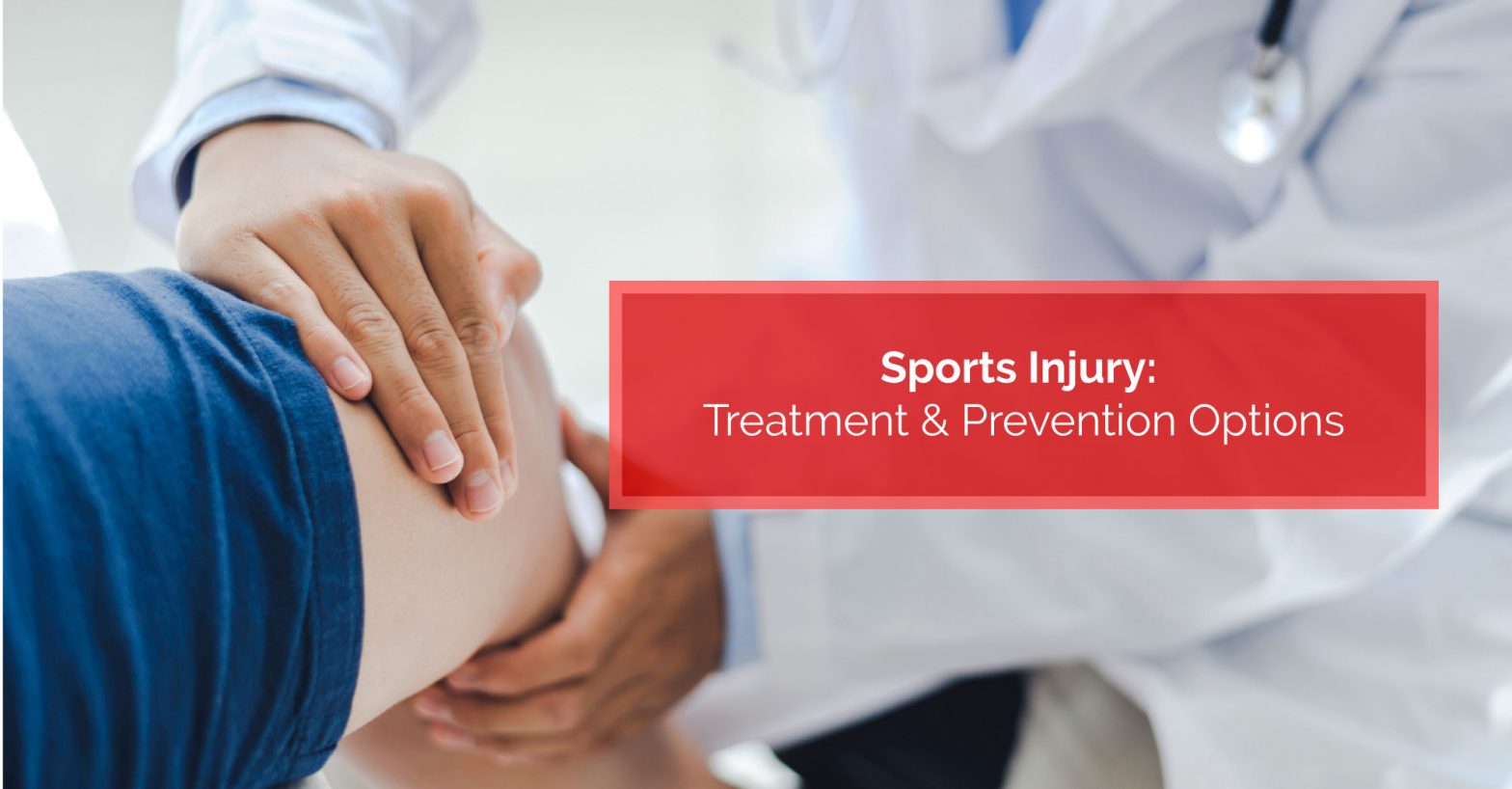Osteoarthritis Treatments: What You Need to Know...
Key Highlights: Osteoarthritis treatments focus on pain relief, restoring joint…
Read More
Posted by Dr. Scott Wilson | 15-May-2023
Sports injuries can be painful and can take you away from the sport you love. They can also take a toll on your mental health and well-being. In this article, we’ll review the major types of sports injuries and the treatment options available to help you recover. We will dive into the RICE method, physiotherapy & exercise, bracing & compression, and other medical treatments that can help speed up your recovery process. We will also discuss how you can prevent sports injuries by enhancing your strength and flexibility, implementing warm-up and cool-down routines, recognizing signs of fatigue, and ensuring proper rest and nutrition. With this information in hand, you can stay safe while enjoying the sport you love!
The main types of injuries athletes experience include sprains and strains, overuse injuries, fractures and dislocations and concussions. Understanding these different types of sports injuries can help you take appropriate precautions and seek timely treatment if an injury occurs.
Sprains and strains are some of the most common sports injuries. They can occur in any part of the body but most often happen in the ankle, knee, and wrist. A sprain is caused by the stretching or tearing of ligaments while a strain results from the stretching or tearing of muscles or tendons. Regardless of which type of injury you experience, the symptoms are fairly common and include pain, swelling, and reduced range of motion.
Overuse injuries are caused by repetitive stress being placed on a particular part of your body. These types of injuries are common among athletes who perform the same motion repeatedly, such as runners, swimmers, or tennis players. Overuse injuries may also occur because of poor conditioning, faulty equipment, or improper technique. Symptoms of overuse injuries often include pain, swelling, stiffness, and reduced range of motion.
Fractures and dislocations are some of the most severe types of sports injuries. A fracture is a break in the bone, while a dislocation occurs when a bone is forced out of its normal position at the joint. These injuries can be caused by sudden impacts, falls, or overuse. Symptoms of fractures include pain, swelling, and difficulty moving the affected area. On the other hand, symptoms of dislocations include visible deformity, intense pain, and swelling. If left untreated, these injuries can lead to long-term complications such as chronic pain or joint instability. It’s crucial to seek medical attention immediately if you suspect you have a fracture or dislocation to prevent further damage.
Concussions and head injuries are some of the most severe sports injuries. They’re caused by a blow to the head or a sudden jolt, leading to mild traumatic brain injury. If left untreated, they can lead to long-term neurological problems. Symptoms of concussion include headache, confusion, dizziness, and sensitivity to light and noise. It’s crucial to seek medical attention immediately if you suspect a concussion or head injury.
When it comes to treating sports injuries, there are several options available depending on the severity of the injury. The RICE method can be helpful in reducing pain and swelling in minor injuries, while physiotherapy can assist in regaining range of motion and rebuilding strength. Bracing and compression can provide support during recovery and even after you’ve returned to action. In more severe cases, surgery may be necessary to repair the damage. It’s important to seek professional advice before deciding on a treatment plan to ensure the best possible outcome.
One of the most well-known treatment options for sports injuries is Rest, Ice, Compression, and Elevation (RICE). This method is a simple but effective way to treat many common sports injuries. Resting the injured area allows the body to begin healing and prevents further damage. Applying ice helps reduce swelling and inflammation. Compression helps limit swelling and provides support to the injured area. Finally, elevating the affected limb can help reduce swelling by allowing fluids to drain away from the injury site. RICE can be used for a variety of injuries, including sprains, strains, and fractures.
Physiotherapy and exercise are essential components of most sports injury treatment and recovery plans. A physiotherapist can create a personalized treatment plan based on your specific injury and recovery needs. This might include passive and active treatment options for pain management, increasing strength and improving flexibility. By incorporating physiotherapy and exercise into your recovery plan, you can experience a faster and more effective recovery while reducing the likelihood of future injuries.
Bracing and compression sleeves are often used to help support and protect injured muscles or joints during recovery. Braces and sleeves are specially designed for specific body parts like knees or ankles and can provide additional stability during physical activity. By providing support to the affected area, they can also help to prevent future injuries. However, to ensure you get the right fit and proper support, it’s important to consult with a healthcare professional before choosing a brace or sleeve. Otherwise, you could be putting yourself at risk of further injury.
In addition to treatments mentioned above, other medical options are available for sports injury recovery. Corticosteroid injections can be administered to alleviate inflammation and pain in the affected area rapidly. Platelet-rich plasma (PRP) therapy is another alternative that can promote healing and reduce pain by using a patient’s blood. And for more severe injuries or those that do not respond to other treatments, surgery may be required. However, to ensure proper diagnosis and care, it is important to consult with a healthcare professional before initiating any form of treatment.
Building strength and flexibility, incorporating proper warm-up and cool down routines, recognizing the signs of fatigue and ensuring proper rest and nutrition are all important for preventing sports injuries.
Proper strength and flexibility training can significantly reduce your risk of experiencing a sports injury. By building strong muscles and supporting joints, strength training can help prevent muscle strains and tears. Flexibility exercises improve range of motion and also decrease the likelihood of muscle strain or tears. Before engaging in any physical activity, it’s essential to follow a proper warm-up routine that includes stretching and some light aerobic exercise.
Proper warm-up and cool-down routines are essential to prevent sports injuries. Warm-ups help increase blood flow to the muscles, loosen joints and prepare the body for physical activity. Cool-downs aid in recovery after intense physical activity. Incorporating stretching exercises into both warm-up and cool-down routines can improve flexibility, reduce muscle soreness and minimize the risk of injury. It is crucial to tailor your warm-up and cool-down routines to the specific sport or activity you’re participating in.
During intense physical activity, recognizing the signs of fatigue can help prevent an injury. These signs may include decreased performance, slower reaction times, and irritability. It’s important to listen to your body and not push beyond your limits. Taking breaks during physical activity and getting enough rest are important for preventing fatigue-related injuries.
Proper rest and nutrition are vital for preventing sports injuries. Getting enough sleep is essential for allowing your body to recover and repair itself. The amount of rest you require depends on the intensity and type of physical activity you perform. However, it can be as important as exercise in supporting your physical performance. Consuming a balanced diet with ample fruits, vegetables, and lean protein can help strengthen your muscles and prevent injuries. Hydration is also crucial for preventing muscle cramps and strains. By listening to your body and taking breaks when needed, rather than simply ignoring the pain or fatigue, you can prevent injuries from happening.
In the case of an injury, especially a more severe one, it’s essential to get professional help as soon as possible. Rest and physiotherapy are crucial to help the body heal naturally. However, in severe cases, surgery may be required. Of course, prevention is always better than cure. By following a few simple steps such as improving your strength and flexibility, warming up properly, recognizing signs of fatigue and ensuring proper rest and nutrition, you can significantly reduce your risk of injury.
If you’ve experienced a sports injury or need expert advice on treatment and prevention, contact us today and let us show you why, at Physiomed, Healthier Starts Here.
Q1: When is surgery necessary for sports injuries?
Surgery is generally considered an option of last resort for sports injuries. However, it may be necessary for severe injuries like ligament tears, fractures, or joint dislocations that do not respond to non-surgical treatments. It’s important to consult with a doctor or orthopedic specialist to determine whether surgery is necessary for your specific injury.
Q2: How long does it typically take to recover from a sports injury?
The recovery time for sports injuries can vary greatly depending on the type and severity of the injury. Proper treatment and rehabilitation are also a key factor when it comes to recovery time. Generally speaking, minor injuries such as sprains or strains may only take a few days to a few weeks to heal, while more serious injuries such as fractures or torn ligaments may take several months.

Key Highlights: Osteoarthritis treatments focus on pain relief, restoring joint…
Read More
Key Highlights: Runner's knee, or patellofemoral pain syndrome, is a…
Read More
Key Highlights: Upper back and neck pain can be caused…
Read More
Key Highlights: Many people want to lose belly fat for…
Read More
Key Highlights: Vestibular physical therapy, or physiotherapy, is a specialized…
Read More
Key Highlights: Tennis elbow, or lateral epicondylitis, is a condition…
Read More